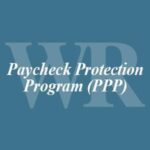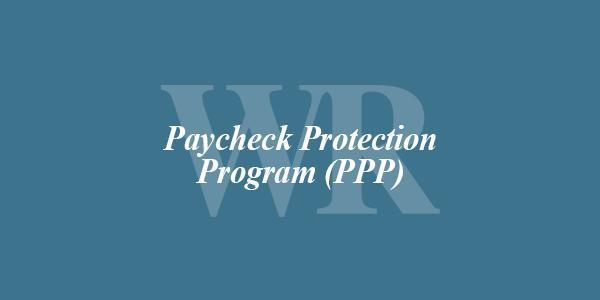
PPPFA Signed and No More “Forgiveness Cliff”
June 25, 2020
PPP Update- New IFR on Forgiveness- Good News for Borrowers
June 27, 2020PPP Update- New Forgiveness Applications

This week marked the original 8-week forgiveness covered period end-date for many of our clients as well as the issuance of the two new PPP loan forgiveness applications. As many of you are, or will be very shortly, deciding on whether or not to use the original 8-week forgiveness period or the new 24-week forgiveness period, we wanted to highlight some of the insights gained from the new applications and share some strategic thoughts to consider.
Note: Please remember we are here to assist you with the loan forgiveness process. We are available to run your forgiveness calculations for you, review the calculations you’ve made, answer any questions you have, and/or discuss potential strategies for your situation. Reach out to your WR Partner or your relationship manager. You can also email our COVID-19 Task Force for assistance.
New PPP Loan Forgiveness Applications
Two new applications were published on Wednesday this week. There is a revised Loan Forgiveness Application and a new Loan Forgiveness Application Form EZ. The revised Loan Forgiveness Application is very similar to the original application issued with changes to reflect the PPP Flexibility Act bill (24-week covered period, 60% of forgiveness amount must be for payroll costs, additional FTE Reduction Exemptions and Safe Harbors). The Loan Forgiveness Application Form EZ is a slightly simpler application that does not include the PPP Schedule A Worksheet to calculate forgiveness reductions and forgiveness reduction safe harbors. The Form EZ can only be used if a borrower meets at least one of the following criteria (summarized):
- Borrower is self-employed and had no employees at time of application
- Borrower did not reduce annual salary or hourly wages of any employee by more than 25% during the Covered Period compared to the benchmark period AND Borrower did not reduce the number of employees or the average paid hours of employees between January 1, 2020 and the end of the Covered Period. **Ignore reductions that qualify for FTE Reduction Safe Harbors which can be found in the IFR from June 1, 2020.
- Borrower did not reduce annual salary or hourly wages of any employee by more than 25% during the Covered Period compared to the benchmark period AND Borrower was unable to operate during the Covered Period at the same level of business activity as before February 15, 2020, due to compliance with requirements established by the Secretary of Health and Human Services, the Director of the Centers for Disease Control and Prevention, or the Occupational Safety and Health Administration, related to the maintenance of standards of sanitation, social distancing, or any other work or customer safety requirement related to COVID-19.
There are published instructions for the Loan Forgiveness Application and instructions for the Loan Forgiveness Application Form EZ. The full criteria for using the Form EZ is found in the Form EZ instructions document.
Thoughts: While the Form EZ is a bit shorter because the forgiveness reduction calculations are not included, it still requires a company to run the same analysis to establish FTE and salary/wage benchmarks and compare them to the covered period to be able to certify they can use the Form EZ. Additionally, both applications will require the same documentation to be submitted with the application or maintained by the borrower to backup the numbers reported and certifications made. The end result is the Form EZ will not significantly reduce the work involved in applying for forgiveness.
Changes for Owner and Owner-Employee Qualified Payroll Costs
The payroll costs calculations for self-employed individuals, general partners, or owner-employees of an S-corporation are different than regular employees and changes were included in the new applications. As a reminder, with the new 24-week covered period an employee’s cash compensation is capped at $100,000 prorated for the 24 weeks. This results in a cash compensation cap of $46,154 per employee ($100,000 * 24/52). For owners (owner-employees, a self-employed individual, or general partners) under the new 24-week forgiveness period, the cash compensation is capped at the 2.5-month equivalent of $100,000 per year ($20,833) for each individual or the 2.5-month equivalent of their applicable compensation in 2019, whichever is lower. Additionally, employer health insurance contributions made on behalf of a self-employed individual, general partners, or owner-employees of an S-corporation do not count towards PPP qualified payroll costs (but they do for employees). Finally, employer retirement contributions made on behalf of self-employed individuals or general partners do not count towards PPP qualified payroll costs but contributions on behalf of owner-employees do qualify and are capped at 2.5 months’ worth of the 2019 contribution amount.
Thoughts: The language in the application changes what we previously believed were qualified payroll costs for owner-employees (owners receiving W-2 wages). The new application removes healthcare benefit payments for owner-employees but leaves in employer retirement plan contributions for them. The application also caps owner-employees’ compensation to 2.5 months of $100,000 as it is for other types of business owners. The ways this is handled seems rather unusual so we will wait to see if there are any future changes made to these rules. **Note: the 2.5-month proration can only be used if a borrower uses the 24-week covered period. The 8/52 proration is still required for borrowers elects to use the original 8-week covered period.
Safe Harbor Date
The PPPFA changed the Safe Harbor date from June 30, 2020 to December 31, 2020. At the time the Act passed we didn’t know if this meant a company would have to wait until December 31 to apply for forgiveness in order to demonstrate the Safe Harbor was met and avoid any forgiveness reduction. The application instructions for Schedule A Worksheet include that the Safe Harbor can be met on the earlier of December 31, 2020 and the date this application is submitted.
Thoughts: This is a welcomed nuance of the application. This will allow companies taking advantage of the Safe Harbor to apply before December 31st and also creates a strategic opportunity for a business to apply at a time that is most beneficial for them before December 31st related to the Safe Harbor calculations. It appears that a borrower will not be required to maintain salary/wages/FTEs through December 31st in order to meet the Safe Harbor requirements.
Use 8-weeks or 24-weeks?
There has been lots of discussion with clients about whether to elect to use the original 8-week covered period or the new 24-week covered period. The answer depends on your unique situation. For many clients the decision involves understanding how much money would be left on the table by using the 8-weeks and weighing that against the risk of not maintaining salary/wages and FTEs for a full 24 weeks. Luckily, the SBA and Treasury have not put a deadline on applying for forgiveness using either period. An approach we have taken with some clients unable to use all of their PPP funds in their 8-week covered period is to go ahead and run all of the calculations and compile all of the necessary documentation as if they were apply using the 8-week period. Then we hold off on applying now and will continue to operate and use the remaining PPP funds appropriately over the next 16 weeks (24 total). Once we get to the end of the 24-week period we will look at that salary/wage/FTE levels and calculate what, if any, impact on forgiveness there would be. We will then be able to compare the calculations for the 8 and 24-week forgiveness periods and determine which provides the best result for forgiveness prior to applying.
If you are a borrower that has been able to use all of your PPP funds on qualified expenses over the 8-weeks and feel confident you should receive 100% forgiveness, going ahead and buttoning down your calculations and documentation to apply for forgiveness now makes sense. We believe some banks will develop online forgiveness application to be completed which we have not seen yet. So, although you may be ready to submit your forgiveness application now, there is a good chance your lender and the SBA aren’t yet.
We will continue to monitor new developments related to the PPP and do our best to share those with you in a timely fashion.
If you need assistance with your loan forgiveness calculations or applications, or you would like to strategically discuss your situation relative to PPP loan forgiveness, we are here to help. Reach out to your WR Partner or your relationship manager. You can also email our COVID-19 task force for assistance: COVID19TASKFORCE@websterrogers.com.


